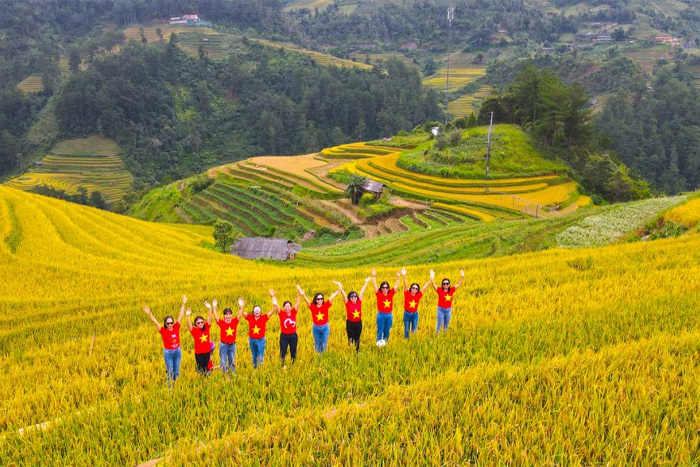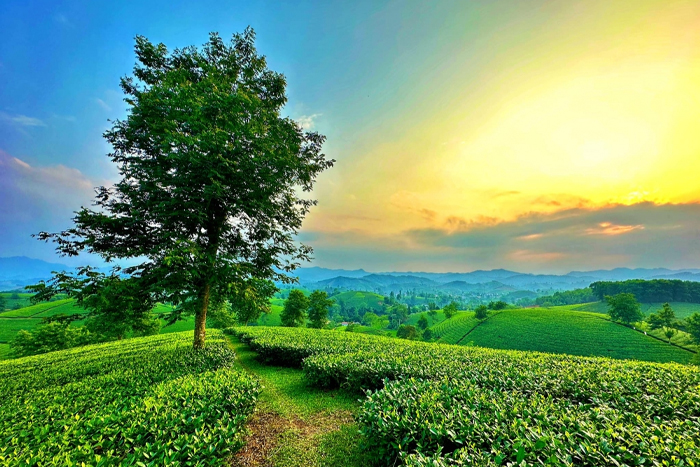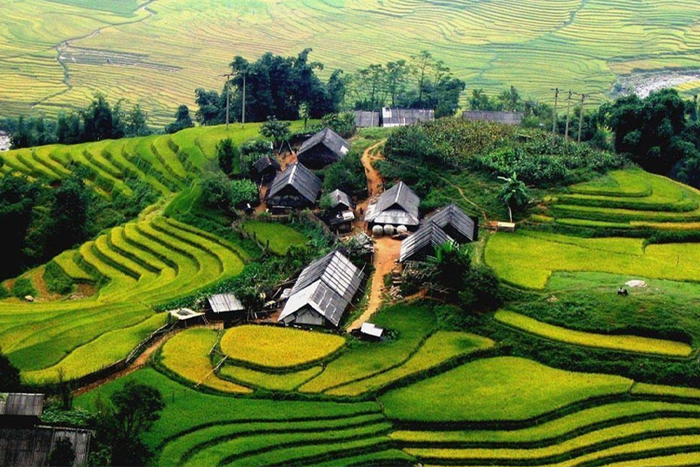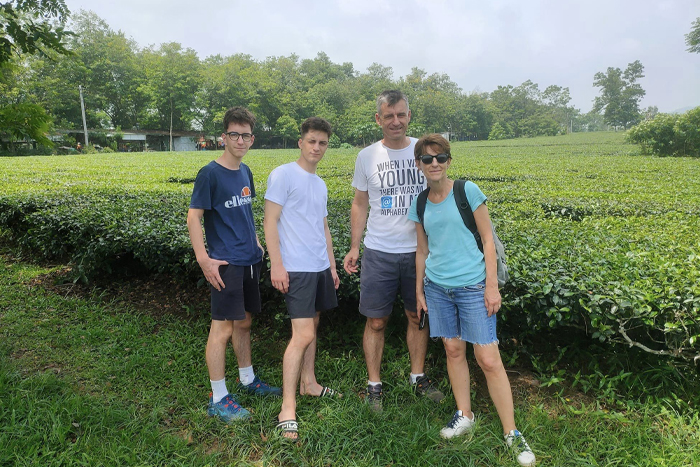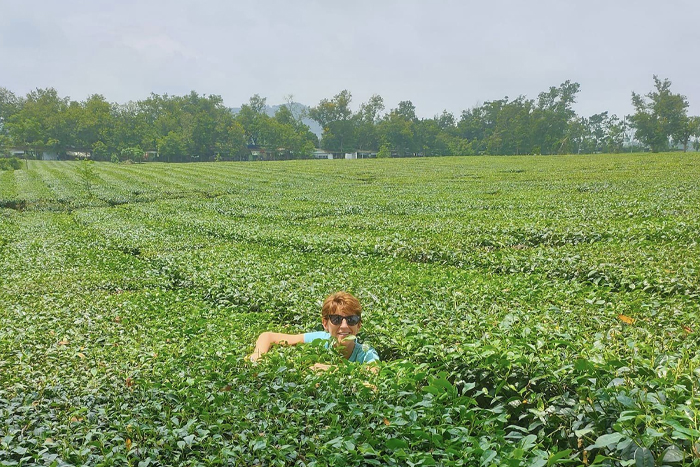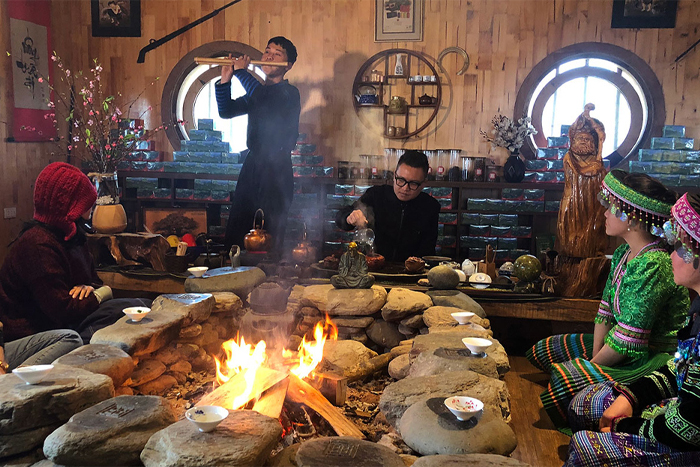
Alongside the stunning terraced rice fields, visitors to Nghia Lo Yen Bai can enjoy vast tea plantations. Nestled in the lush mountains of Yen Bai province in northern Vietnam, the Nghia Lo tea plantation offers a mesmerizing escape into a world of endless green. This hidden gem, relatively unknown to mass tourism, provides a unique opportunity for travelers to immerse themselves in the serene beauty of Vietnam's tea country. Join Autour Asia as we explore the captivating Nghia Lo tea plantation, where every season brings its own charm, and every visit leaves you with a deeper appreciation for the timeless beauty of Vietnam's highlands.
I. Overview of Nghia Lo tea plantation
Nestled about 80 km southwest of Yen Bai Province, Nghia Lo is becoming a captivating destination for travelers seeking an authentic mountain life experience. Before reaching Nghia Lo Yen Bai, visitors pass through and can visit centuries-old Shan Tuyet tea trees, one of the most famous teas of the hill tribe people in northwest Vietnam. Additionally, visitors can capture stunning photos at Nghia Lo tea plantation, a picturesque location nestled among the mountains, known for its beautiful tea hills.
Nghia Lo tea plantations are nestled in Nghia Lo commune, Nghia Lo town, Yen Bai province, Vietnam. This area is known for its expansive agricultural and forestry lands, and it's the only part of Nghia Lo town with tea plantations. Over the years, tea has become the main crop here, helping many local families escape poverty and build better lives.
The area's history is closely tied to the Nghia Lo tea farm, which was set up after the famous Dien Bien Phu campaign. Nghia Lo farm town was once one of three major farms in Van Chan district, Yen Bai. In recent years, the local people have been pioneers in improving tea production. They've introduced new tea varieties, embraced modern farming techniques, and brought in machinery to help with production. These changes have revolutionized how tea is grown and processed here, significantly improving the lives of the tea farmers in the process.
II. What to do at Nghia Lo tea hills?
1. Sightseeing and photography
When visiting the Nghia Lo tea plantations, you'll find a variety of engaging activities to enjoy. The lush green landscapes provide a perfect backdrop for sightseeing and photography, especially during the golden hours of early morning or late afternoon. Early mornings often bring a misty atmosphere, ideal for capturing ethereal images as the sun rises over the plantations. Throughout the day, the changing light transforms the scenery, offering diverse photographic opportunities. During harvest, you might spot local tea pickers at work, adding a cultural element to your photos.
2. Tea picking experience
The tea picking experience at Nghia Lo Yen Bai offers visitors a hands-on opportunity to immerse themselves in a centuries-old tradition. As you step into the lush tea fields, you'll be greeted by rows upon rows of neatly trimmed tea bushes, their green leaves glistening in the sunlight. For a hands-on experience, you can try your hand at tea picking, learning from locals how to select and pluck the young tea buds.
3. Tea tasting and shopping
To deepen your understanding of tea production, consider visiting local processing facilities. Here, you can witness the journey of tea leaves from fresh picks to final products. Don't miss the opportunity to sample various local teas, particularly the renowned Shan Tuyet tea that this region is famous for.
Nghia Lo tea plantations also offer a chance for cultural immersion. Engage in conversations with local residents to gain insights into their way of life and traditions. If you're looking for mementos, you can purchase tea and related products as souvenirs. For nature enthusiasts, there are trails winding through the tea plantations perfect for hiking and exploring, allowing you to soak in the scenery and fresh mountain air.
4. Discover other tea plantations
In addition to Nghia Lo tea plantation, nearby visitors can also explore other tea plantations in Van Chan district, such as Van Chan tea plantation and Suoi Giang tea plantation.
Van Chan tea plantations are a beautiful green tea region that has contributed to the local economy and created a picturesque agricultural landscape in Yen Bai province. Located on the outskirts of Nghia Lo farm town, these expansive tea plantations have been cultivated for over 50 years, covering about 4,700 hectares, making it one of the largest tea-producing areas in the district. The hills offer a cool climate and straight paths through the tea plantations, making it an ideal spot for watching the sunset.
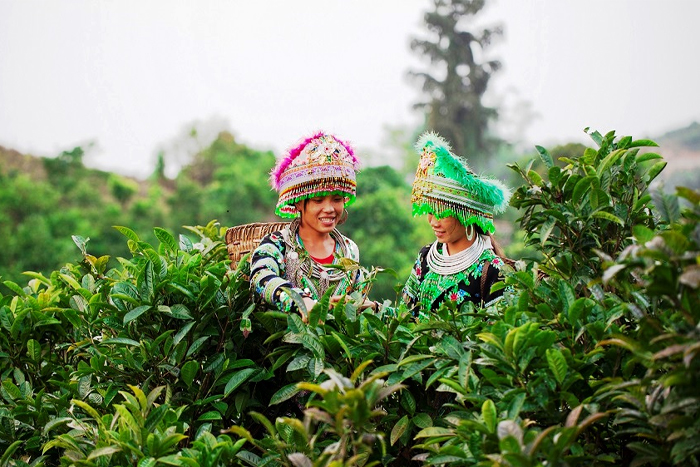
Suoi Giang tea hills, located at an elevation of over 1,400 meters above sea level, are home to some of Vietnam's most unique and ancient tea trees. These giant old tea trees are large enough to support several adults. Suoi Giang tea is famous for its delicious flavor. When tasting, you might first experience a slightly bitter sensation, but this quickly gives way to a sweet, clear taste from the fresh green tea buds. Visiting Suoi Giang in early winter to enjoy a hot cup of tea while overlooking Nghia Lo town from above can be a memorable and relaxing experience.
Both these tea hill areas offer visitors a chance to experience the beauty of Yen Bai's tea country, each with its own unique characteristics and charm.
III. Some useful travel tips
Here are some useful travel tips for visiting the tea plantations in Nghia Lo Yen Bai:
Transportation: Rent a motorbike or car for flexibility in exploring the are or Book a tour if you're not comfortable navigating on your own
Accommodation: Stay in Nghia Lo town for more options; Consider homestays in ethnic minority villages for a more authentic experience
Clothing: Wear comfortable, breathable clothing suitable for walking Bring a light jacket or sweater as temperatures can be cool, especially in early mornings and evenings
Footwear: Choose sturdy, comfortable shoes for walking on uneven terrain
Sun protection: Bring a hat, sunglasses, and sunscreen as you'll be outdoors a lot
Insect repellent: Useful for protection against mosquitoes and other insects
Camera: Bring a good camera to capture the scenic landscapes
Cash: Carry sufficient cash as ATMs may be limited in rural areas
Respect local customs: Ask permission before taking photos of people or in villages
Tea etiquette: Learn basic tea tasting etiquette to fully appreciate the experience
Visiting
Nghia Lo tea plantation is often combined with tours to explore other attractive tourist destinations in Yen Bai province such as
Nghia Lo,
Tu Le valley and
Mu Cang Chai. To craft a truly memorable journey through this stunning region of Vietnam, contact AUTOUR ASIA,
Vietnam Travel Agency specializing in Northwest Vietnam
The green tea farms of Nghia Lo Yen Bai in Vietnam, offer a captivating blend of natural beauty and cultural heritage. These verdant hillsides not only produce quality tea but also provide stunning vistas and insights into traditional agriculture. Combined with nearby attractions like rice terraces and ethnic villages, Nghia Lo tea plantations offer a unique, immersive experience of Vietnam's northwest. Whether you're passionate about tea or simply seeking scenic beauty, these farms promise an unforgettable journey into the heart of Vietnam's tea country.
How to get to Mu Cang Chai Yen Bai from Nghia Lo?
If you start from Hanoi, here is our recommendation " How to get to Mu Cang Chai from Hanoi".
To get to Mu Cang Chai Yen Bai from Nghia Lo, take a 80-kilometer road trip south on QL32. It typically takes about 2.5 to 3 hours by car or motorbike through scenic mountainous landscapes. For convenience, consider arranging a private transfer or checking local bus options.
Where to stay in Nghia Lo?
Where to stay in Nghia Lo Yen Bai? In Nghia Lo, you'll find a variety of accommodations to choose from for your trip, including options like Binh Nga Homestay, Muong Lo Hotel, Nghia Lo Hotel, and more. Nghia Lo homestay is also the best choice for visitors to enjoy the best trip in Yen Bai Vietnam.

